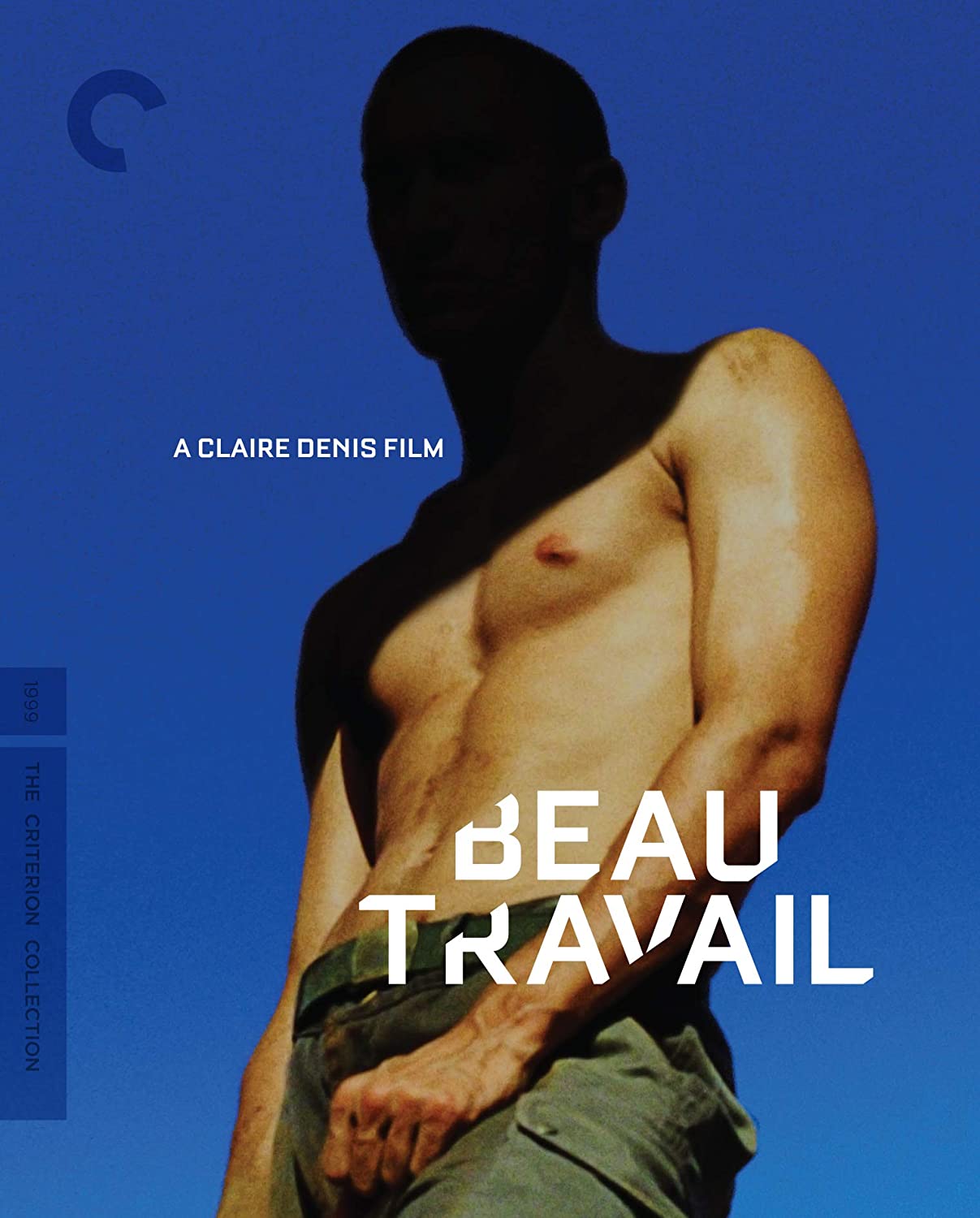Blu-ray: Beau Travail | reviews, news & interviews
Blu-ray: Beau Travail
Blu-ray: Beau Travail
Claire Denis' 1999 Foreign Legion film retains its thrilling elemental mystery

This fifth feature from Claire Denis must surely be the director’s most sheerly concentrated film.
This is a soldier’s life seen not through combat – when we see a gun, it’s assessed almost as an aesthetic object, something of functional beauty – but through accretive routine, from ritualised training to off-base R&R, out of which the story’s final confrontation builds. Denis fused a variety of source elements, from Herman Melville’s Billy Budd – that writer’s poetry is crucial, too, as are the excerpts from Brittten’s eponymous opera that feature as monumental sound accompaniment – to the visual mythology of the Foreign Legion itself. Though terms like “homo-erotic” can be easily bandied about, the director offers no such simple elucidations: that element is downplayed, compared to Melville at least, subsumed by a jealousy that comes straight out of Othello.
 In the conversation with Moonlight director Barry Jenkins that is one of this release’s extras, Denis reprises the well-known story of how she came to be commissioned by broadcaster ARTE as part of a strand intended to explore the theme of the “foreign”. She jokes about the easy associative leap that took her directly to the Foreign Legion, but the link is rather deeper: that entity, separated from the usual structures of society (of the French army, too) in every sense, embodies in itself an idea of “foreignness”, felt not least in the dislocation of its unit in the alien territory of Africa. In Denis Lavant’s Galoup, the sergeant whose rigorous loyalty to his unit is disrupted by the appearance of Grégoire Colin’s routine-disrupting recruit Sentain, Denis explores the concept of what she has called being “a foreigner to oneself”.
In the conversation with Moonlight director Barry Jenkins that is one of this release’s extras, Denis reprises the well-known story of how she came to be commissioned by broadcaster ARTE as part of a strand intended to explore the theme of the “foreign”. She jokes about the easy associative leap that took her directly to the Foreign Legion, but the link is rather deeper: that entity, separated from the usual structures of society (of the French army, too) in every sense, embodies in itself an idea of “foreignness”, felt not least in the dislocation of its unit in the alien territory of Africa. In Denis Lavant’s Galoup, the sergeant whose rigorous loyalty to his unit is disrupted by the appearance of Grégoire Colin’s routine-disrupting recruit Sentain, Denis explores the concept of what she has called being “a foreigner to oneself”.
Showcasing a new 4K restoration, this Criterion release has interviews with both Lavant and Colin, the former offering a generous overview that takes in how he came to be involved in the project: he was an outsider there, too, the main company of 15 actors having trained in Paris for two months to build physical bonding, Lavant joining them on set only the day before filming began.
But it’s the selected scene commentary from cinematographer Agnès Godard that comes closest to catching the essence of Beau Travail, from the desert terrain of “excessively spiritual” Djibouti (“infinity on every axis”, Godard recalls) to how their experience of effectively “blind” shooting – there were no dailies to watch – led to pushing boundaries: as Denis described it, “we did a film with what we did not have.” The extra is only 16 minutes, but Godard touches on all the key facets of the film, from the rituals of Legion life choreographed by ballet dancer Bernardo Montet – the duel de regard between Galoup and Sentain, that striking moment of physical group hugging, the unrelenting observation of the battalion in rote training, on land and sea alike – to the astonishing final scene in which Lavant delivers a hypnotic dance of self-release to the disco beat of Corona’s “The Rhythm of the Night”.
Even Denis seems uncertain just how that “dance between life and death” came about: she had used that phrase to suggest to the actor something of what might be inspiring Galoup, but the result came entirely from the actor’s improvisation, in just two takes. Transposed in editing to its closing-scene position, it's one of those unpredictable moments in filmmaking that colours the entire work, a fitting symbol in itself for so brave a piece of cinematic exploration.
rating
Share this article
The future of Arts Journalism
You can stop theartsdesk.com closing!
We urgently need financing to survive. Our fundraising drive has thus far raised £49,000 but we need to reach £100,000 or we will be forced to close. Please contribute here: https://gofund.me/c3f6033d
And if you can forward this information to anyone who might assist, we’d be grateful.

Subscribe to theartsdesk.com
Thank you for continuing to read our work on theartsdesk.com. For unlimited access to every article in its entirety, including our archive of more than 15,000 pieces, we're asking for £5 per month or £40 per year. We feel it's a very good deal, and hope you do too.
To take a subscription now simply click here.
And if you're looking for that extra gift for a friend or family member, why not treat them to a theartsdesk.com gift subscription?
more Film
 The Mastermind review - another slim but nourishing slice of Americana from Kelly Reichardt
Josh O'Connor is perfect casting as a cocky middle-class American adrift in the 1970s
The Mastermind review - another slim but nourishing slice of Americana from Kelly Reichardt
Josh O'Connor is perfect casting as a cocky middle-class American adrift in the 1970s
 The Perfect Neighbor, Netflix review - Florida found-footage documentary is a harrowing watch
Sundance winner chronicles a death that should have been prevented
The Perfect Neighbor, Netflix review - Florida found-footage documentary is a harrowing watch
Sundance winner chronicles a death that should have been prevented
 Blu-ray: Le Quai des Brumes
Love twinkles in the gloom of Marcel Carné’s fogbound French poetic realist classic
Blu-ray: Le Quai des Brumes
Love twinkles in the gloom of Marcel Carné’s fogbound French poetic realist classic
 Frankenstein review - the Prometheus of the charnel house
Guillermo del Toro is fitfully inspired, but often lost in long-held ambitions
Frankenstein review - the Prometheus of the charnel house
Guillermo del Toro is fitfully inspired, but often lost in long-held ambitions
 London Film Festival 2025 - a Korean masterclass in black comedy and a Camus classic effectively realised
New films from Park Chan-wook, Gianfranco Rosi, François Ozon, Ildikó Enyedi and more
London Film Festival 2025 - a Korean masterclass in black comedy and a Camus classic effectively realised
New films from Park Chan-wook, Gianfranco Rosi, François Ozon, Ildikó Enyedi and more
 After the Hunt review - muddled #MeToo provocation
Julia Roberts excels despite misfiring drama
After the Hunt review - muddled #MeToo provocation
Julia Roberts excels despite misfiring drama
 London Film Festival 2025 - Bradley Cooper channels John Bishop, the Boss goes to Nebraska, and a French pandemic
... not to mention Kristen Stewart's directing debut and a punchy prison drama
London Film Festival 2025 - Bradley Cooper channels John Bishop, the Boss goes to Nebraska, and a French pandemic
... not to mention Kristen Stewart's directing debut and a punchy prison drama
 Ballad of a Small Player review - Colin Farrell's all in as a gambler down on his luck
Conclave director Edward Berger swaps the Vatican for Asia's sin city
Ballad of a Small Player review - Colin Farrell's all in as a gambler down on his luck
Conclave director Edward Berger swaps the Vatican for Asia's sin city
 London Film Festival 2025 - from paranoia in Brazil and Iran, to light relief in New York and Tuscany
'Jay Kelly' disappoints, 'It Was Just an Accident' doesn't
London Film Festival 2025 - from paranoia in Brazil and Iran, to light relief in New York and Tuscany
'Jay Kelly' disappoints, 'It Was Just an Accident' doesn't
 Iron Ladies review - working-class heroines of the Miners' Strike
Documentary salutes the staunch women who fought Thatcher's pit closures
Iron Ladies review - working-class heroines of the Miners' Strike
Documentary salutes the staunch women who fought Thatcher's pit closures
 Blu-ray: The Man in the White Suit
Ealing Studios' prescient black comedy, as sharp as ever
Blu-ray: The Man in the White Suit
Ealing Studios' prescient black comedy, as sharp as ever
 The Woman in Cabin 10 review - Scandi noir meets Agatha Christie on a superyacht
Reason goes overboard on a seagoing mystery thriller
The Woman in Cabin 10 review - Scandi noir meets Agatha Christie on a superyacht
Reason goes overboard on a seagoing mystery thriller

Add comment